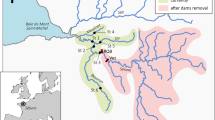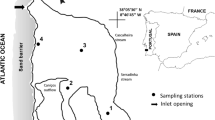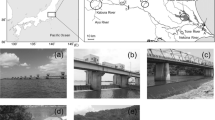Abstract
Life-history traits of eels display a high level of phenotypic plasticity in response to large-scale biogeographical drivers, as well as local conditions encountered during the continental phase. Here, we provided a biogeographical snapshot of the variability of life-history traits of eels (Anguilla anguilla), across a large proportion of their natural distribution range. Silver eels (n = 99) were collected across eleven European catchments to investigate how life-history traits vary along geographical and saline habitats, as it was inferred from the Sr:Ca ratio in otoliths. Among 13 life-history traits tested, 3 of them such as total length, body or liver weight were related to geographical coordinates. Overall, eels grow faster in southern Europe and migrate earlier suggesting that the silvering process is related to the local growth conditions more than fish age. The salinity profiles revealed by the otoliths’ Sr:Ca ratios indicate that eels with a brackish life-history generally grow faster, reach larger size-at-age, and have a better condition than eels living in freshwater. This observation associated with the lower abundance of the sanguivorous swimbladder nematode, Anguillicola crassus, confirms the importance of brackish areas for sustaining the eel production. A large proportion of the observed variation of life-history traits remained unexplained by the biogeographical trends and salinity condition, which suggests that other drivers act at the catchment scale.







Similar content being viewed by others
Data availability
The data that support the findings of this study are available from the corresponding author upon reasonable request.
References
Acou A, Lefebvre F, Contournet P, Poizat G, Panfili J, Crivelli AJ (2003) Silvering of female eels (Anguilla anguilla) in two sub-populations of the Rhone Delta. Bull Fr Pêche Piscic 368:55–68. https://doi.org/10.1051/kmae:2003036
Acou A, Boury P, Laffaille P, Crivelli AJ, Feunteun E (2005) Towards a standardized characterization of the potentially migrating silver European eel (Anguilla anguilla, L.). Arch Für Hydrobiol 164:237–255. https://doi.org/10.1127/0003-9136/2005/0164-0237
Acou A, Gabriel G, Laffaille P, Feunteun E, Casselman JM, Cairns DK (2009) Differential production and condition indices of premigrant eels in two small Atlantic coastal catchments of France. In Eels at the Edge: Science, Status, and Conservation Concerns. Amer Fish Soc Symp 58:157–174
Acou A, Virag L, Reveillac E, Boulenger C, Feunteun E (2013) Comment, à partir d’un seul otolithe, âger une anguille sans exclure d’autres analyses ? Colloq Natl Sclérochronologie, Rennes, 2 au 4 juillet 2013
Arai T, Otake T, Tsukamoto K (1997) Drastic changes in otolith microstructure and microchemistry accompanying the onset of metamorphosis in the Japanese eel Anguilla japonica. Mar Ecol Prog Ser 161:17–22. https://doi.org/10.3354/meps161017
Aroua S, Schmitz M, Baloche S, Vidal B, Rousseau K, Dufour S (2005) Endocrine evidence that silvering, a secondary metamorphosis in the eel, is a pubertal rather than a metamorphic event. Neuroendocrinology 82:221–232. https://doi.org/10.1159/000092642
Belpaire CGJ, Goemans G, Geeraerts C, Quataert P, Parmentier K, Hagel P, De Boer J (2009) Decreasing eel stocks: survival of the fattest? Ecol Freshw Fish 18:197–214. https://doi.org/10.1111/j.1600-0633.2008.00337.x
Belpaire C, Hodson P, Pierron F, Freese M (2019) Impact of chemical pollution on Atlantic eels: facts, research needs, and implications for management. Curr Opin Environ Sci Heal 11:26–36. https://doi.org/10.1016/j.coesh.2019.06.008
Bourillon B, Acou A, Trancart T, Belpaire C, Covaci A, Bustamante P, Faliex E, Amilhat E, Malarvannan G, Virag L, Aarestrup K, Bervoets L, Boisneau C, Boulenger C, Gargan P, Becerra-Jurado G, Lobón-Cerviá J, Mae GE, Pedersen MI, Poole R, Sjöberg N, Wickström H, Walker A, Righton D, Feunteun E (2020) Assessment of the quality of European silver eels and tentative approach to trace the origin of contaminants – A European overview. Sci Total Environ 743:140675. https://doi.org/10.1016/j.scitotenv.2020.140675
Bourillon B, Feunteun E, Acou A, Trancart T, Teichert N, Belpaire C, Dufour S, Bustamante P, Aarestrup K, Walker A, Righton D (2022) Anthropogenic contaminants shape the fitness of the endangered European Eel: a machine learning approach. Fishes 7:274. https://doi.org/10.3390/fishes7050274
Cairns DK, Secor DA, Morrison WE, Hallett JA (2009) Salinity-linked growth in anguillid eels and the paradox of temperate-zone catadromy. J Fish Biol 74:2094–2114. https://doi.org/10.1111/j.1095-8649.2009.02290.x
Chang YLK, Feunteun E, Miyazawa Y, Tsukamoto K (2020) New clues on the Atlantic eels spawning behavior and area: the Mid-Atlantic Ridge hypothesis. Sci Rep 10:1–12. https://doi.org/10.1038/s41598-020-72916-5
Clevestam PD, Ogonowski M, Sjöberg NB, Wickström H (2011) Too short to spawn? Implications of small body size and swimming distance on successful migration and maturation of the European eel Anguilla anguilla. J Fish Biol 78:1073–1089. https://doi.org/10.1111/j.1095-8649.2011.02920.x
Colombo G, Grandi G, Rossi R (1984) Gonad differentiation and body growth in Anguilla anguilla L. J Fish Biol 24:215–228. https://doi.org/10.1111/j.1095-8649.1984.tb04792.x
Daverat F, Tomas J (2006) Tactics and demographic attributes in the European eel Anguilla anguilla in the Gironde watershed, SW France. Mar Ecol Prog Ser 307:247–257. https://doi.org/10.3354/meps307247
Daverat F, Tomas J, Lahaye M, Palmer M, Elie P (2005) Tracking continental habitat shifts of eels using otolith Sr/Ca ratios: validation and application to the coastal, estuarine and riverine eels of the Gironde–Garonne–Dordogne watershed. Mar Freshw Res 56:619–627. https://doi.org/10.1071/MF04175
Daverat F, Limburg KE, Thibault I, Shiao JC, Dodson JJ, Caron F, Tzeng WN, Iizuka Y, Wickström H (2006) Phenotypic plasticity of habitat use by three temperate eel species, Anguilla anguilla, A. japonica and A. rostrata. Mar Ecol Prog Ser 308:231–241. https://doi.org/10.3354/meps308231
Daverat F, Beaulaton L, Poole R, Lambert P, Wickström H, Andersson J, Aprahamian M, Hizem B, Elie P, Yalçın-Özdilek S, Gumus A (2012) One century of eel growth: changes and implications. Ecol Freshw Fish 21:325–336. https://doi.org/10.1111/j.1600-0633.2011.00541.x
Denis J, Mahé K, Amara R (2022) Abundance and growth of the European Eels (Anguilla anguilla Linnaeus, 1758) in small estuarine habitats from the Eastern English channel. Fishes 7(5):213. https://doi.org/10.3390/fishes7050213
Dormann CF, Elith J, Bacher S, Buchmann C, Carl G, Carré G, Marquéz JRG, Gruber B, Lafourcade B, Leitão PJ, Münkemüller T, Mcclean C, Osborne PE, Reineking B, Schröder B, Skidmore AK, Zurell D, Lautenbach S (2013) Collinearity: a review of methods to deal with it and a simulation study evaluating their performance. Ecography 36:027–046
Dufour S, Burzawa-Gerard E, Le Belle N, Sbaihi M, Vidal B (2003) Reproductive endocrinology of the European eel, Anguilla Anguilla. Eel Biology. Springer, Tokyo, pp 373–383. https://doi.org/10.1007/978-4-431-65907-5_25
Durif C, Dufour S, Elie P (2005) The silvering process of Anguilla anguilla: a new classification from the yellow resident to the silver migrating stage. J Fish Biol 66:1025–1043
Durif C, Diserud OH, Sandlund OT, Thorstad EB, Poole R, Bergesen K, Escobar-Lux RH, Shema S, Vøllestad LA (2020) Age of European silver eels during a period of declining abundance in Norway. Ecol Evol 10:4801–4815. https://doi.org/10.1002/ece3.6234
Feunteun E, Laffaille P, Robinet T, Briand C, Baisez A, Olivier JM, Acou A (2003) A review of upstream migration and movements in inland waters by anguillid eels: toward a general theory. Eel biology. Springer, Tokyo, pp 191–213. https://doi.org/10.1007/978-4-431-65907-5_14
Geffroy B, Bardonnet A (2016) Sex differentiation and sex determination in eels: consequences for management. Fish Fish 17:375–398. https://doi.org/10.1111/faf.12113
Gérard C, Trancart T, Amilhat E, Faliex E, Virag L, Feunteun E, Acou A (2013) Influence of introduced vs. native parasites on the body condition of migrant silver eels. Parasite 20:38. https://doi.org/10.1051/parasite/2013040
Helfman GS, Facey DE, Hales Jr LS, Bozeman Jr EL (1987) Reproductive ecology of the American eel. In American Fisheries Society Symposium. p. 42–56
ICES (2020) Third workshop on age reading of European and American eel (WKAREA3). ICES Sci Rep 2(84):34. https://doi.org/10.17895/ices.pub.7483
Itakura H, Yokouchi K, Kanazawa T, Matsumoto M, Matoba T, Wakiya R, Shirai K, Ishimatsu A (2020) Diverse downstream migration patterns of the anadromous Japanese grenadier anchovy Coilia nasus in the Chikugo River estuary and Ariake Sea Japan. Reg Stud Mar Sci 39:101436. https://doi.org/10.1016/j.rsma.2020.101436
Jessop BM (2010) Geographic effects on American eel (Anguilla rostrata) life history characteristics and strategies. Can J Fish Aquat Sci 67:326–346. https://doi.org/10.1139/F09-189
Jessop BM, Cairns DK, Thibault I, Tzeng WN (2008) Life history of American eel Anguilla rostrata: new insights from otolith microchemistry. Aquat Biol 1:205–216. https://doi.org/10.3354/ab00018
Lavielle M (1999) Detection of multiple changes in a sequence of dependent variables. Stoch Process Appl 83:79–102. https://doi.org/10.1016/S0304-4149(99)00023-X
Lavielle M (2005) Using penalized contrasts for the change-point problem. Signal Process 85:1501–1510. https://doi.org/10.1016/j.sigpro.2005.01.012
López-de-Lacalle J (2016) tsoutliers R package for detection of outliers in time series. CRAN, R Packag
Mac Nally R (2000) Regression and model-building in conservation biology, biogeography and ecology: the distinction between–and reconciliation of–‘predictive’ and ‘explanatory’models. Biodivers Conserv 9:655–671
Mac Nally R (2002) Multiple regression and inference in ecology and conservation biology: further comments on retention of independent variables. Biodivers Conserv 11:1397–1401
Mac Nally R, Walsh CJ (2004) Hierarchical partitioning public-domain software. Biodivers Conserv 13:659–660. https://doi.org/10.1023/B:BIOC.0000009515.11717.0b
MacNamara R, McCarthy TK (2012) Size-related variation in fecundity of European eel (Anguilla anguilla). ICES J Mar Sci 69:8. https://doi.org/10.1093/icesjms/fss123
MacNamara R, McCarthy TK, Wickström H, Clevestam PD (2016) Fecundity of silver-phase eels (Anguilla anguilla) from different habitat types and geographic locations. ICES J Mar Sci 73:135–141. https://doi.org/10.1093/icesjms/fsv065
Maes GE, Raeymaekers JAM, Pampoulie C, Seynaeve A, Goemans G, Belpaire C, Volckaert FAM (2005) The catadromous European eel Anguilla anguilla (L.) as a model for freshwater evolutionary ecotoxicology: relationship between heavy metal bioaccumulation, condition and genetic variability. Aquat Toxicol 73:99–114. https://doi.org/10.1016/j.aquatox.2005.01.010
Marohn L, Jakob E, Hanel R (2013) Implications of facultative catadromy in Anguilla anguilla. Does individual migratory behaviour influence eel spawner quality? J Sea Res 77:100–106. https://doi.org/10.1016/j.seares.2012.10.006
Mateo M, Lambert P, Tetard S, Castonguay M, Ernande B, Drouineau H (2017) Cause or consequence? Exploring the role of phenotypic plasticity and genetic polymorphism in the emergence of phenotypic spatial patterns of the European eel. Can J Fish Aquat Sci 74:987–999. https://doi.org/10.1139/cjfas-2016-0214
Miller MJ, Bonhommeau S, Munk P, Castonguay M, Hanel R, McCleave JD (2015) A century of research on the larval distributions of the Atlantic eels: a re-examination of the data. Biol Rev 90:1035–1064. https://doi.org/10.1111/brv.12144
Miller MJ, Westerberg H, Sparholt H, Wysujack K, Sørensen SR, Marohn L, Jacobsen MW, Freese M, Ayala DJ, Pohlmann JD (2019) Spawning by the European eel across 2000 km of the Sargasso Sea. Biol Lett 15:20180835
Oliveira K (1999) Life history characteristics and strategies of the American eel, Anguilla rostrata. Can J Fish Aquat Sci 56:795–802. https://doi.org/10.1139/f99-001
Otake T, Ishii T, Nakahara M, Nakamura R (1994) Drastic changes in otolith strontium/calcium ratios in leptocephali and glass eels of Japanese eel Anguilla japonica. Mar Ecol Prog Ser 112:189–193
Palstra AP, Heppener DFM, Van Ginneken VJT, Székely C, Van den Thillart G (2007) Swimming performance of silver eels is severely impaired by the swim-bladder parasite Anguillicola crassus. J Exp Mar Bio Ecol 352:244–256. https://doi.org/10.1016/j.jembe.2007.08.003
Parzanini C, Arts MT, Power M, Rohtla M, Skiftesvik AB, Koprivnikar J, Browman HI, Milotic D, Durif CM (2021) Trophic ecology of the European eel (Anguilla anguilla) across different salinity habitats inferred from fatty acid and stable isotope analysis. Can J Fish Aquat Sci 78(11):1721–1731. https://doi.org/10.1139/cjfas-2020-0432
Patin R, Etienne MP, Lebarbier E, Benhamou S (2019) segclust2d: Bivariate Segmentation/Clustering Methods and Tools. R Packag. version 0.2.0
Patin R, Etienne MP, Lebarbier E, Chamaillé-Jammes S, Benhamou S (2020) Identifying stationary phases in multivariate time series for highlighting behavioural modes and home range settlements. J Anim Ecol 89:44–56. https://doi.org/10.1111/1365-2656.13105
R Core Team (2018) R: A language and environment for statistical computing. R Foundation for Statistical Computing, Vienna, Austria. https://www.R-project.org/
Righton D, Westerberg H, Feunteun E, Økland F, Gargan P, Amilhat E, Metcalfe J, Lobon-Cervia J, Sjöberg N, Simon J, Acou A, Vedor M, Walker A, Trancart T, Brämick U, Aarestrup K (2016) Empirical observations of the spawning migration of European eels: the long and dangerous road to the Sargasso Sea. Sci Adv 2:e1501694. https://doi.org/10.1126/sciadv.1501694
Robinet TT, Feunteun EE (2002) Sublethal effects of exposure to chemical compounds: a cause for the decline in Atlantic eels? Ecotoxicology 11:265–277. https://doi.org/10.1023/A:1016352305382
Sauvaget B, Fatin D, Briand C (2003) Contamination by Anguillicola crassus of five coastal eel populations (Anguilla anguilla) in Brittany (France). Bull Fr Pêche Piscic 76:21–28
Svedäng H, Wickström H (1997) Low fat contents in female silver eels: indications of insufficient energetic stores for migration and gonadal development. J Fish Biol 50:475–486
Tabouret H, Bareille G, Claverie F, Pécheyran C, Prouzet P, Donard OFX (2010) Simultaneous use of strontium: calcium and barium: calcium ratios in otoliths as markers of habitat: application to the European eel (Anguilla anguilla) in the Adour basin, South West France. Mar Environ Res 70:35–45. https://doi.org/10.1016/j.marenvres.2010.02.006
Teichert N, Lizé A, Tabouret H, Gérard C, Bareille G, Acou A, Carpentier A, Trancart T, Virag LS, Robin E, Druet M, Prod’Homme J, Feunteun E (2022) A multi-approach study to reveal eel life-history traits in an obstructed catchment before dam removal. Hydrobiologia 849(8):1885–1903. https://doi.org/10.1007/s10750-022-04833-9
Tesch FW (2003) The Eel. Blackwell, Oxford
Tsukamoto K, Arai T (2001) Facultative catadromy of the eel Anguilla japonica between freshwater and seawater habitats. Mar Ecol Prog Ser 220:265–276
Tsukamoto K, Nakai I (1998) Do all freshwater eels migrate? Nature 396:635–636. https://doi.org/10.1038/25264
Van den Thillart G, Palstra A, Van Ginneken V (2007) Simulated migration of European silver eel; swim capacity and cost of transport. J Mar Sci Technol 15(5):1
Vélez-Espino LA, Koops MA (2010) A synthesis of the ecological processes influencing variation in life history and movement patterns of American eel: towards a global assessment. Rev Fish Biol Fish 20:163–186. https://doi.org/10.1007/s11160-009-9127-0
Vøllestad LA (1992) Geographic variation in age and length at metamorphosis of maturing European eel: environmental effects and phenotypic plasticity. J Anim Ecol 61:41–48. https://doi.org/10.2307/5507
Walsh CJ, Papas PJ, Crowther D, Sim PT, Yoo J (2004) Stormwater drainage pipes as a threat to a stream-dwelling amphipod of conservation significance, Austrogammarus australis, in southeastern Australia. Biodivers Conserv 13:781–793. https://doi.org/10.1023/B:BIOC.0000011726.38121.b0
Walsh C, Mac Nally R (2013) hier.part: hierarchical partitioning. R package version 1.0–4. https://CRAN.R-project.org/package=hier.part
Acknowledgements
The international EELIAD project (https://cordis.europa.eu/project/id/212133/reporting) was coordinated by Cefas (UK) and funded by the European Union FP7 research program on Environment (grant GOCE-2008212133). We are very grateful to the two anonymous reviewers for their comments and suggestions that have contributed to improve the relevance and quality of our manuscript. We especially thank the professional fishermen and all the people involved in the eel sampling, particularly Håkan Wickström and Niklas Sjöberg (Swedish University of Agricultural Sciences), Kim Aarestrup and Michael Ingemann Pedersen (Technical University of Denmark), Michael Godard (Cefas, England), Liz Baldwin (Environment Agency, England), Russell Poole (Marine Institute, Ireland), Paddy Gargan and Gustavo Becerra-Jurado (Inland Fisheries, Ireland), Claude Belpaire (INBO, Belgium), Gregory E. Maes (KU Leuven, Belgium), Elisabeth Faliex and Elsa Amilhat (Perpignan University, France), Clarisse Boulenger (Agrocampus of Rennes, France), Catherine Boisneau (University of Tours, France), Sylvie Dufour (BOREA, France) and Javier Lobón-Cerviá (Madrid National Museum of Natural Science, Spain), as well as participation of colleagues for eel dissections (R. Gadais, R. Lecomte-Finiger, S. Pottier, E. Réveillac and G. Simon). We thank Professor Katsumi Tsukamoto from the University of Tokyo who invited E. Feunteun in his laboratory at the Atmosphere and Ocean Research Institute, University of Tokyo) to measure strontium (Sr) and calcium (Ca).
Author information
Authors and Affiliations
Contributions
NT: methodology, Formal analysis, Visualization, Writing—original draft. BB: Data curation, Methodology, Writing—review & editing. KS: investigation, data curation, writing—review and editing. AA: methodology, data curation, validation, writing—review and editing. AC: writing—review and editing. MK: resources, writing—review and editing. DR: conceptualization, funding acquisition, writing—review and editing. TT: writing—review and editing. L-sV: methodology, investigation, and data curation. AW: resources, investigation, writing—review and editing. TO: resources, writing—review and editing. ÉF: conceptualization, supervision, project administration, validation, writing—review and editing.
Corresponding author
Ethics declarations
Conflict of interest
The authors declare that they have no known competing financial interests or personal relationships that could have appeared to influence the work reported in this paper.
Additional information
Publisher's Note
Springer Nature remains neutral with regard to jurisdictional claims in published maps and institutional affiliations.
Rights and permissions
Springer Nature or its licensor (e.g. a society or other partner) holds exclusive rights to this article under a publishing agreement with the author(s) or other rightsholder(s); author self-archiving of the accepted manuscript version of this article is solely governed by the terms of such publishing agreement and applicable law.
About this article
Cite this article
Teichert, N., Bourillon, B., Suzuki, K. et al. Biogeographical snapshot of life-history traits of European silver eels: insights from otolith microchemistry. Aquat Sci 85, 39 (2023). https://doi.org/10.1007/s00027-023-00940-4
Received:
Accepted:
Published:
DOI: https://doi.org/10.1007/s00027-023-00940-4




